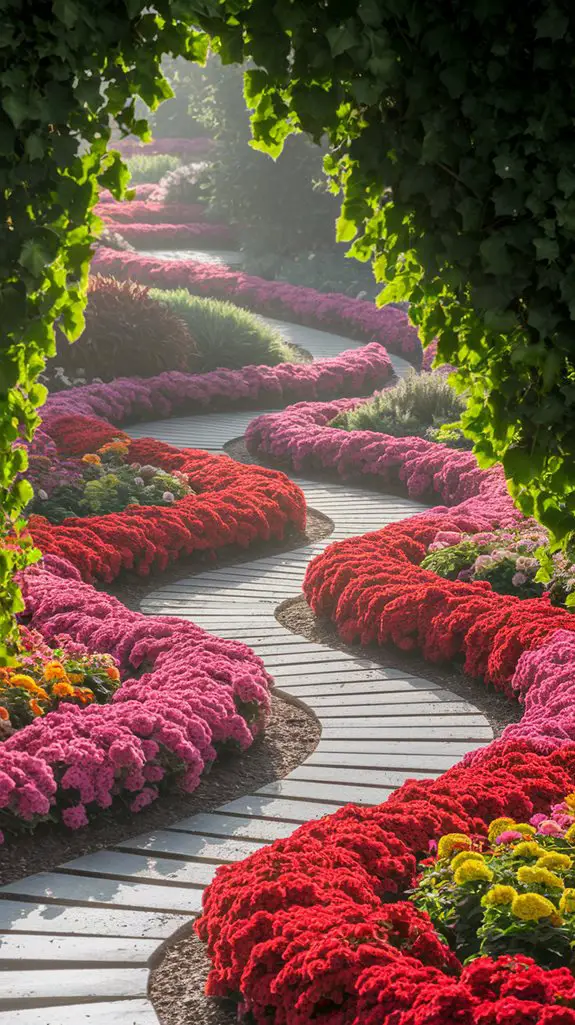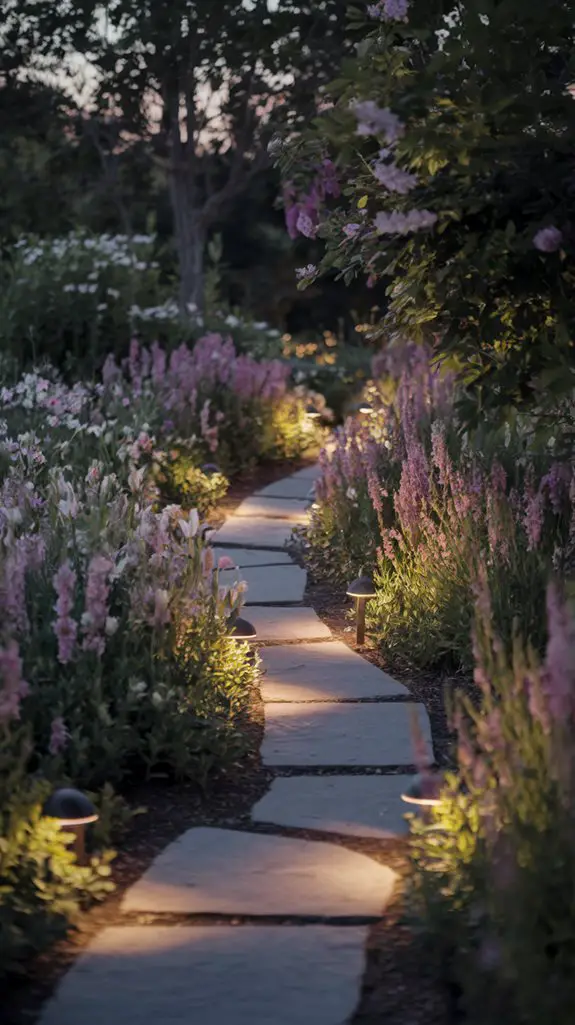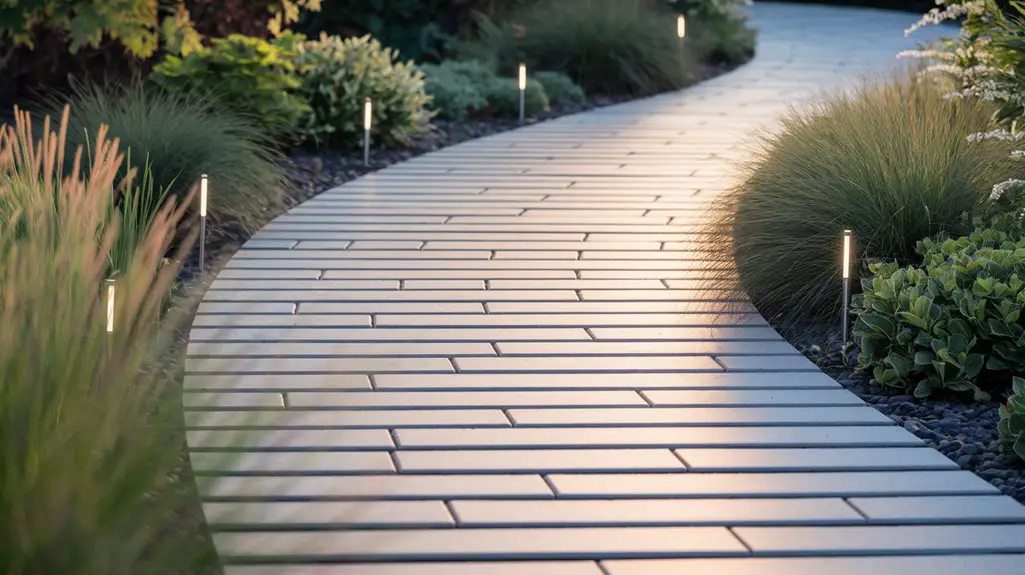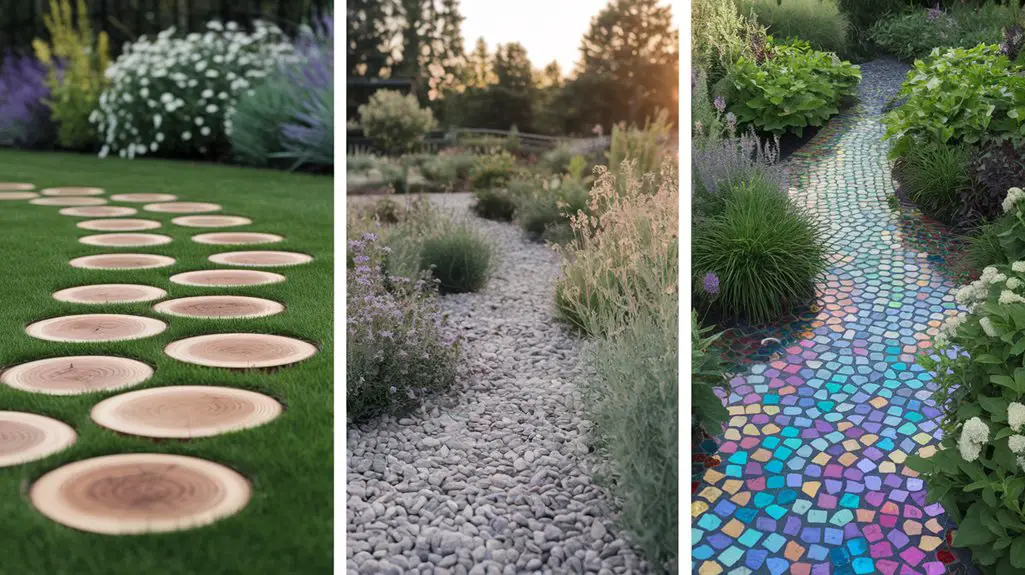Your garden blooms deserve more than just a functional route from point A to B—they need pathways that enhance their natural beauty. Well-designed garden paths don’t just guide your steps; they frame your botanical treasures and invite exploration. By focusing on materials, curves, lighting, fragrance, proportions, borders, and rest areas, you’ll transform ordinary walkways into garden features worthy of admiration. These seven strategies will elevate your garden’s design while making every journey through your floral sanctuary a delight.
Choose Natural Materials That Complement Your Blooms
Three key natural materials can transform your garden pathways from mere thoroughfares into design statements that enhance your blooming landscape.
Decomposed granite offers a warm, earthy backdrop that won’t compete with vibrant flowers while providing excellent drainage during rainy seasons. Its fine texture creates a sophisticated contrast against lush plantings.
Flagstone presents a more structured option with its irregular shapes and varied hues of blues, tans, and russets. You’ll find these natural tones echo the subtle colors in your perennials and provide stable footing year-round.
For woodland gardens, consider bark mulch pathways. They’ll soften the landscape while suppressing weeds and retaining soil moisture. The rich brown tones create a perfect foundation for highlighting white blooms and chartreuse foliage nearby. Additionally, garden walkways can create a seamless flow throughout your outdoor space, enhancing the overall aesthetic.
Design Curved Paths to Create Visual Interest

While straight paths efficiently connect garden destinations, curved pathways invite exploration and create a sense of mystery in your flower garden.
Gentle curves draw the eye through the landscape and encourage visitors to slow down and appreciate your blooming displays.
When designing curved paths for maximum visual impact:
- Use flowing, sinuous curves rather than tight zigzags—aim for natural contours that mimic streams or rolling hills.
- Position focal points like decorative containers or specimen plants at curve junctions to reward exploration.
- Vary the width of your path—narrower sections in intimate areas, wider curves where you want people to pause.
- Frame curves with different heights of plantings to create layers of discovery as visitors round each bend.
Incorporating colorful garden path ideas can further enhance the allure of your flower garden pathways.
Add Landscape Lighting for Evening Garden Strolls

Transforming your garden pathway into a magical nighttime experience requires thoughtful landscape lighting that balances safety with aesthetic appeal.
Consider installing low-voltage LED path lights spaced 6-8 feet apart to guide movement without overwhelming the space.
Moonlighting—placing fixtures in trees to cast dappled shadows—creates a natural, ethereal effect on your pathways. For focal points like specimen plants or water features, use spotlights with narrow beams.
Warm white (2700K) bulbs complement flowers and foliage, while cooler tones (4000K) enhance blue and white blooms. Additionally, using pathway lighting options can elevate the overall ambiance of your garden.
Don’t forget to illuminate steps and level changes for safety.
Solar options provide eco-friendly convenience, though they typically emit softer light.
Modern smart lighting systems let you adjust brightness and color seasonally, extending your garden’s enjoyment well into evening hours.
Incorporate Fragrant Plants Along Path Edges
Strategically placing fragrant plants along your garden pathway edges creates a multisensory experience that elevates simple walks into immersive journeys.
Select varieties that release their scents at different times of day to guarantee continuous fragrance from dawn until dusk.
- Position low-growing lavender, thyme, and chamomile where they’ll brush against visitors’ legs, releasing their essential oils with each touch.
- Install night-blooming jasmine or evening primrose near garden benches to enhance twilight relaxation spots.
- Plant aromatic herbs like mint, rosemary, and sage at path intersections to create defined fragrance zones.
- Consider seasonal blooming cycles—combine spring lilacs, summer roses, and fall witch hazel for year-round scent.
Remember to place stronger-scented varieties farther apart to prevent olfactory overwhelm and allow each plant’s unique fragrance profile to be appreciated individually.
Balance Width and Scale for Comfortable Navigation
Designing pathways with appropriate width and scale guarantees garden navigation feels intuitive and natural rather than cramped or unnecessarily expansive. You’ll want primary walkways to accommodate two people walking side-by-side, typically 4-5 feet wide, while secondary paths can be 2-3 feet wide for single-file strolling. Additionally, incorporating creative garden pathway design ideas can enhance the overall aesthetic of your garden.
| Path Type | Recommended Width | Best Applications |
|---|---|---|
| Primary | 4-5 feet | Main garden arteries, entrances |
| Secondary | 2-3 feet | Side routes, intimate spaces |
| Stepping | 18-24 inches | Casual access, maintenance areas |
| Formal | 3-6 feet | Structured gardens, focal approaches |
Consider your garden’s overall size when planning path widths—a small cottage garden needs narrower trails than an expansive landscape. Remember that curves should widen slightly to maintain visual flow and prevent awkward navigation.
Integrate Weather-Resistant Path Markers and Borders
Weather-resistant path markers and borders serve three essential functions in your flower garden: they define walking areas clearly, prevent soil erosion, and add architectural interest regardless of season.
When selecting materials for your pathway borders, prioritize durability and visual harmony with your garden’s aesthetic.
Consider these weather-resistant border options:
- Marine-grade aluminum edging – Sleek, modern look that won’t rust or deteriorate when exposed to moisture
- Composite plastic lumber – Eco-friendly alternative that resists rot, cracking, and fading while mimicking natural wood
- Treated concrete curbing – Custom-poured borders that create seamless, continuous edges resistant to frost heave
- Natural stone pavers – Timeless elegance with excellent freeze-thaw durability when properly installed on a gravel base
Additionally, incorporating budget-friendly pathway ideas can enhance your garden’s charm without breaking the bank. You’ll appreciate these long-lasting solutions through every season and weather condition.
Include Strategic Resting Points With Seating Areas
A well-planned flower garden pathway becomes truly inviting when you incorporate thoughtful resting points along the journey. Position benches or chairs at strategic locations where visitors can pause to admire focal points or particularly stunning plantings.
Consider placing seating at pathway intersections, near water features, or in areas that capture ideal garden views. Choose materials that complement your pathway design—wrought iron for formal gardens, rustic wood for cottage aesthetics, or stone benches for timeless appeal.
You’ll enhance the experience by adding small side platforms or nooks that don’t interrupt traffic flow.
Don’t overlook comfort elements such as shade from pergolas or trees, nearby fragrant plants, and small tables for beverages or books. These thoughtful resting areas transform your garden from a mere walkway into a destination worth lingering in. Additionally, incorporating creative outdoor seating options can provide versatility and comfort throughout the seasons.
Conclusion
Well-designed garden paths aren’t just beautiful—they’re transformative. Studies show that homes with thoughtfully landscaped pathways can increase property values by up to 20%. As you implement these seven design principles, you’ll create more than just a way to navigate your garden; you’ll craft an immersive experience that invites lingering, exploration, and appreciation. Your pathway isn’t merely functional—it’s the narrative thread that ties your garden story together.



